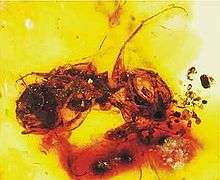Melittosphex burmensis
Melittosphex burmensis is one of the two oldest-known species of bees. The species was described from an amber inclusion in Burmese Amber in the year 2006 by George Poinar, Jr., a zoologist at Oregon State University. The fossil was found in a mine in the Hukawng Valley of northern Myanmar and is believed to date from the Cretaceous Period, 100 million years ago.[1]
| Melittosphex burmensis | |
|---|---|
 | |
| Scientific classification | |
| Kingdom: | Animalia |
| Phylum: | Arthropoda |
| Class: | Insecta |
| Order: | Hymenoptera |
| Superfamily: | Apoidea |
| Family: | †Melittosphecidae Poinar & Danforth, 2006 |
| Genus: | †Melittosphex Poinar & Danforth, 2006 |
| Species: | †M. burmensis |
| Binomial name | |
| †Melittosphex burmensis Poinar & Danforth, 2006 | |
Etymology
Melitta is a form of the Greek word μέλισσα (melissa), "honey bee",[2] while Sphex is a transliteration of the Greek word σφήξ, wasp.[3]
Description
M. burmensis is approximately one-fifth the size of the extant honeybee, at about 3 millimetres long. It is not closely related to any extant bee family.[4] M. burmensis has some anatomical features similar to those of flesh-eating wasps, including the shape of its hind legs, but also some features of pollen-collecting bees, such as branched hairs on the body. The bee's head is heart-shaped.
The sample discovered is thought to be 100 million years old, 40 million years older than the next-oldest known bee species at the time. In 2020, a second new species in a different genus and family, Discoscapa apicula, was described from the same amber deposit.[5] The discovery of bees from the Cretaceous Period with certain pollen-collecting features may help to explain the rapid expansion of flowering plants at that time in earth's history.
Poinar and bee researcher Bryan Danforth described M. burmensis in the journal Science.
References
- G. O. Poinar, Jr. & B. N. Danforth (2006). "A fossil bee from Early Cretaceous Burmese amber". Science. 314 (5799): 614. CiteSeerX 10.1.1.627.551. doi:10.1126/science.1134103. PMID 17068254.
- μέλισσα, Henry George Liddell, Robert Scott, An Intermediate Greek-English Lexicon, on Perseus.
- "Sphex". Merriam-Webster. Retrieved 22 June 2015.
- Danforth, Bryan N.; Poinar, George O. (September 2011). "Morphology, Classification, and Antiquity of Melittosphex burmensis (Apoidea: Melittosphecidae) and Implications for Early Bee Evolution". Journal of Paleontology. 85 (5): 882–891. doi:10.1666/10-130.1. ISSN 0022-3360.
- George Poinar Jr (2020). "Discoscapidae fam. nov. (Hymenoptera: Apoidea), a new family of stem lineage bees with associated beetle triungulins in mid-Cretaceous Burmese amber". Palaeodiversity. 12 (1): 1–9. doi:10.18476/pale.v13.a1.
- OSU media release on discovery
- http://www.nytimes.com/aponline/us/AP-Ancient-Bee.html (New York Times registration required)
- AAAS News release. Images included